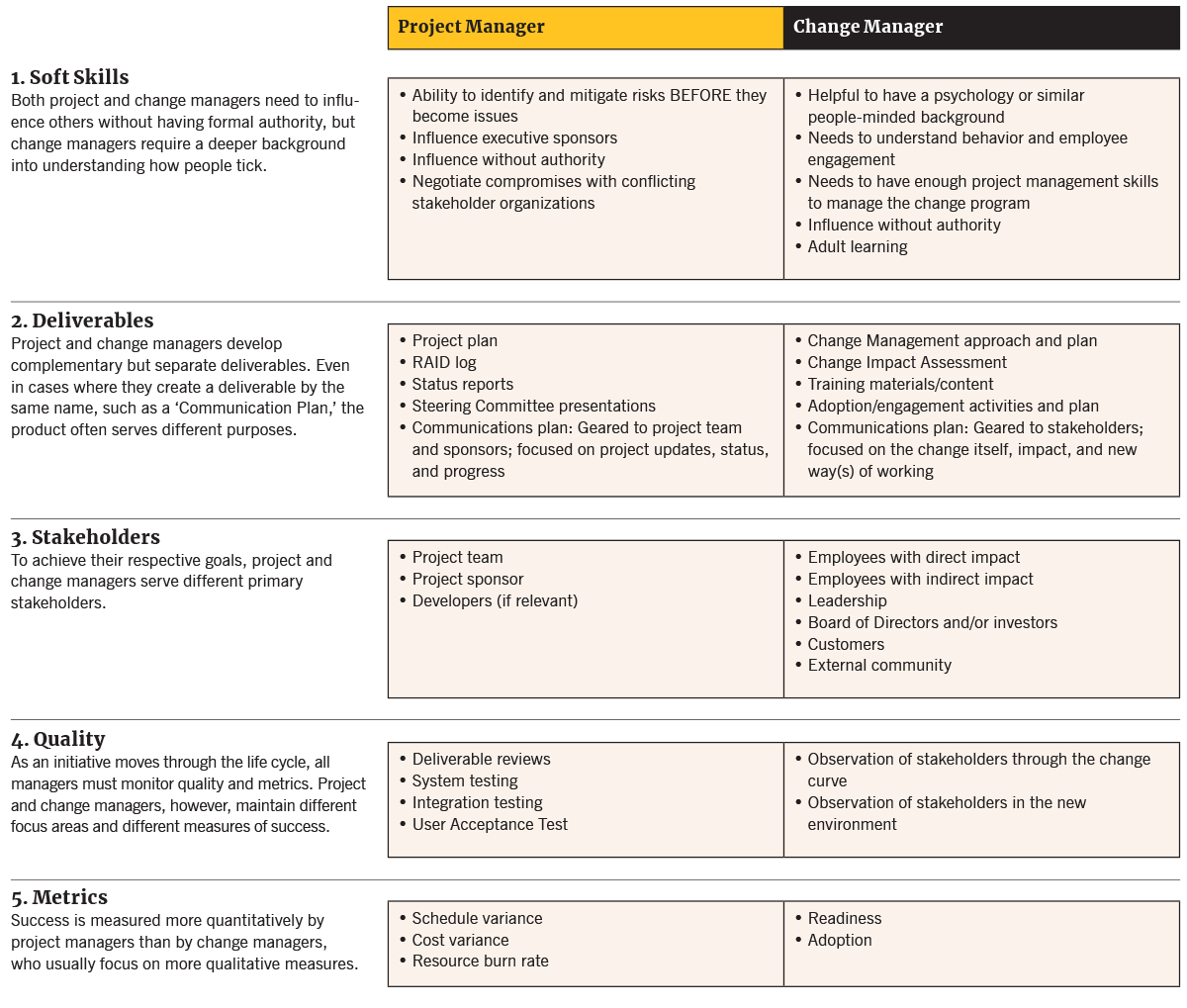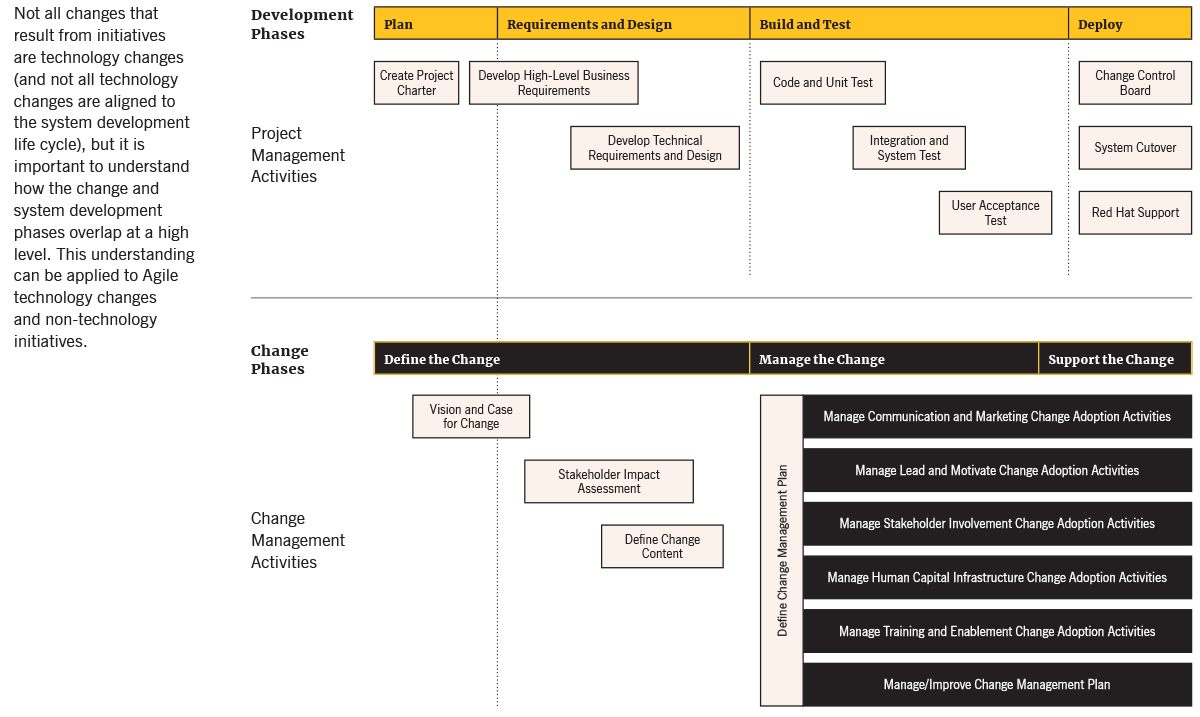Implementing a new initiative — whether it is a new customer relationship management (CRM) system, an updated workflow process, or a new governance approach — means change. You cannot introduce something new without making changes to whatever was in place before. Project management and change management — two separate and specialized business functions — should work together to achieve success. Unfortunately, this partnership frequently does not occur as it should because many do not appreciate the unique value that each role brings.
Far too often, inexperienced leaders combine both functions into a single role and fill it with someone lacking the requisite skill sets. Other times, organizations launch major initiatives but focus on only one area — either project or change management — to the exclusion of the other. Consider these two opposing case studies:
Case Study #1:
All Project Management, No Focus on Change
A large, multinational client brought in a strong project Management Office (PMO) team to implement a new order entry system. To develop high-level requirements regarding the data elements to capture, they engaged only a limited number of stakeholders from each region and neglected to consider how the new system would change the stakeholders’ day-to-day jobs or help them be successful. The PMO drove the vendor to deliver the build on time and under budget, but rather than implement user acceptance testing, they pushed primarily for system and integration testing.
As a result, users strongly resisted the system. Not only did it require them to document additional data points for which they couldn’t see the value, but the amount of time it took also significantly reduced the number of sales they could make per shift. In the end, a new order entry system designed to drive sales decreased them. Worse, it resulted in a highly disgruntled workforce. Sure, the system was delivered on time and under budget, and met the technical requirements, but without proper user buy-in, its full benefits were never realized.
Case Study #2:
All Change Management, Limited Project Management
Another client took the opposite approach and established a strong change management (CM) team to design training for a major system implementation. The CM team worked with the project management and IT groups to learn the system, co-created scenarios with identified “super users” to develop relevant training examples and validated those scenarios with employees across all levels and functions of the organization.
Not only were those training validation sessions for the developed material, but the sessions were also used as a change management tool to raise awareness and understanding of the new system and its associated benefits — for both the company and individual employees. The result was a training program highly specific to the organization and employees who were excited about using the new system. They understood the benefits of the updated technology and how the system would save data entry and process time and reduce errors.
Unfortunately, the project ran out of money shortly after the first round of pilot training was conducted — the technology development was more expensive than anticipated — and the entire program was canceled. As a result, discouraged employees were left knowing that there was a better way to do the job, but it was out of their reach. Now lacking trust in management, they are more likely to be hesitant about the company’s next big push to implement substantial change.
What can we learn from these case studies?
Both case studies highlight an important but often-overlooked point: Leaders should recognize that while PM and CM are separate functions, they must work in alignment to achieve project success and sustained adoption. It simply costs too much not to have both the project and change managers’ perspectives and skills. What good is a system if no one is using it correctly or to its fullest extent?
In addition to examining these differences across five major areas, including soft skills, deliverables, and metrics, we will outline three important ways to integrate project managers and change managers so that your projects will be delivered on time, within budget, and with changes readily adopted for sustained value.
Five Key Differences Between Project and Change Managers
To understand why organizations can’t simply use just project or change management, it helps to understand how each role takes a different approach to the same project. Fundamentally, the two roles maintain disparate skill sets and are driven by different measures of success. And while both are necessary, rarely does one person boast all the tools needed to implement the initiative. However, if you do find that elusive unicorn who is skilled at both project management and change management, it’s important to consider if they have the capacity or bandwidth to be successful.
If they possess the skills, one person can conceivably assume both roles for smaller projects. For larger projects, however, the lift for both the project manager and change manager is usually too heavy for one full-time employee. And for enterprise-wide transformations, consider adding multiple people with project management and change management skill sets. When hiring a project or change manager, consider these differences across five important areas.


Despite the Differences, There Are Three Steps to Successfully Integrate Project and Change Management
The project management — change management partnership is not limited to deliverables. The roles must communicate and talk to each other — all the time. Project and change managers must understand each other’s perspectives, goals, and metrics. Change managers and project managers bring different but complementary skills and perspectives to the table and must be able to bridge and balance the two disciplines on projects. For an initiative to be successful, both must assume an active role.
To get started, here are three effective ways to leverage the synergy of both project and change management on your next new initiative:
#1: Start the Partnership From the Beginning
The project management — change management partnership needs to begin by aligning change and project management metrics in the project charter document. For example, the need for business requirements to be completed on time is a great example of where that alignment is important: project managers must relay the importance of that milestone to change managers, who will use the future-state requirements to identify the impacts to stakeholders and create the plan to minimize that impact.
#2: Ensure That the Critical Path Includes Change Activities
The critical path to deployment needs to include change activities. Throughout project execution, managers must collaborate on the RAID log to talk about how scheduling gaps may impact the user/employee experience and vice versa. Change management needs to be an agenda item in project meetings on a regular, ongoing basis. Likewise, status reports need to include progress against readiness and adoption goals. This is second nature for schedule and budget, but it should be for change management as well.
#3: Continue Change Support After the Project Ends
The partnership should continue even after deployment. Project managers will likely focus on post go-live support to address any system issues and negotiate warranty coverage with the vendor, while the change managers support the employees’ (or external stakeholders’, like customers’) perspective of adoption and support. All system issues are not created equal, and this is an opportunity for the roles to be complementary as they work together to prioritize the resolution of technical issues that are most impactful on system adoption.
